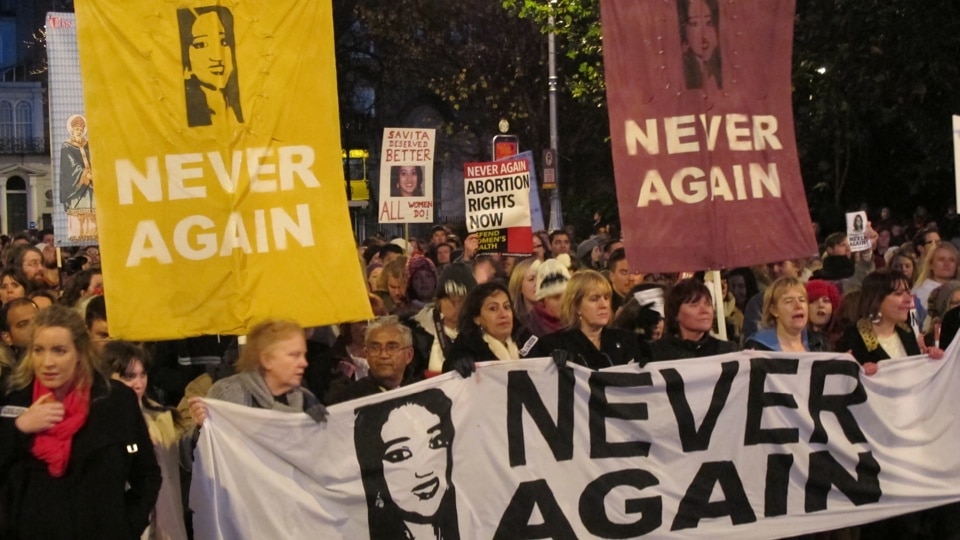by Ann Rossiter
On the Issues Special Correspondent – Dublin, Ireland
A 17-weeks pregnant woman with severe back pain is admitted to a hospital in the west of Ireland. After an examination, she is told that her cervix is fully dilated; her amniotic fluid leaking. Her immature fetus will not survive. This is made clear to her. She is also told that once she miscarries her ordeal will be over and she can return home. But this never happens. A spontaneous abortion does not occur in the four or five hours predicted by the consultant gynecologist. The woman and her husband are informed that because the fetal heartbeat is still present, no intervention is possible. In spite of her repeated requests for an abortion, the woman is refused. Her husband says they were told that abortion “is against the law.” He says they were told, “this is a Catholic country.”

Three days later the fetal heartbeat does stops and the woman is taken to an operating room for an evacuation of the contents of her womb. Due to her high temperature and low heart and pulse rate she is transferred to the intensive care unit. She is placed on antibiotics but deteriorates rapidly and goes into multi-organ failure
Seven days after admission to hospital, surrounded by modern equipment and well-trained staff, she dies of septicaemia. The woman is just one of an indeterminate number of women left to die when abortions could have saved their lives. The woman’s death notice on the website RIP.ie merely gives her name and states: ‘suddenly at University Hospital Galway’.
As many throughout the world know by now, the woman in question was Savita Halappanavar. She was 31, a practicing dentist from the state of Karnataka in south-west India who lived in Galway City with her husband Praveen, a chemical engineer at Boston Scientific, a large multi-national manufacturer of medical devices. This was to be their first child.
Since Savita’s death, Praveen’s unwavering commitment to seeking justice for his wife by exposing the horrific narrative of her treatment has resulted in the case going international and viral. In Ireland the media’s perception of Savita as a young, ‘exotic’, middle-class Indian health professional also contributed to wall-to-wall coverage almost to the exclusion of all else, even the desperate state of the economy. Reeling from shock and ridden with existentialist angst, everybody, everywhere on the entire island seemed to talk of nothing else.
People poured onto the streets to join vigils, rallies and demonstrations. There was palpable anger – rage even – but it was controlled since the protestors were also grieving. In Galway, the city that had become home to Savita, she was remembered with dignity and grace in candlelight vigils. Participants carrying her portrait bearing the captions: “Never again” and “She had a heartbeat too.” At the largest protest, in Dublin, at least 10,000 people (some counts put it closer to 20,000) gathered on November 17 for a march that began at the city’s Garden of Remembrance dedicated to those who died for Ireland’s freedom in the War of Independence. This is a spot laden with nationalist symbolism and that was not lost on those marching for another kind of freedom. They marched through O’Connell Street, the main thoroughfare, to the Dail, the seat of government. Vigils and marches also took place in Belfast and Derry in Northern Ireland — where abortion is legal under British law but virtually unobtainable. Vigils were also held outside the Irish Embassy in London, in the United States with its enormous population of citizens of Irish descent, as well as recent emigrants and throughout the world.
“But I am neither Catholic or Irish; I am Hindu and Indian.”
Public protests, demonstrations and vigils also sprang up in cities and towns in India. There was coverage in both national and local newspapers on a scale not seen since the ‘Quit India’ movement of the 1940s aimed at ending British rule. The Times of India led its online coverage with the headlines: “Ireland murders pregnant Indian dentist,” and “Savita would not have died in an Indian hospital”. Cyberspace reverberated with Savita’s retort on learning she was being denied an abortion on legal and religious grounds: “But I am neither Catholic or Irish; I am Hindu and Indian.”
Ireland’s image of itself as “a happy go lucky” kind of place, a land of “a hundred thousand welcomes,” as peddled by the Irish Tourist Board, was being challenged by another image, that of a backward and hostile environment in regard to the reproductive rights of women. Without doubt, there has been considerable progress made in the fields of female education, employment and representation over the last decades. However, Ireland is still a place where women are compelled to supply their bodies for the sustenance of the fetus independently of their wishes and needs, and independently even of whether they consented to becoming pregnant. Further, the Republic’s 1937 constitution still dictates that a mother’s place is in the home.
In a poignant and apt observation in his Irish Times column on November 17, the journalist Fintan O’Toole wrote that “Savita and Praveen Halappanavar walked unknowingly into Ireland’s grey zone of hidden realities, unspoken truths and word games” where the difference made in the wording of the Constitution between a threat to a woman’s “life” and to her “health” can be a matter of life or death. The couple may not have known – there was no government health warning to alert them – that the writ of a nineteenth century British statute still runs. The 1861 Offences Against the Person Act (under which Oscar Wilde was prosecuted for sodomy) has been replaced in Britain itself with the 1967 Abortion Act. However, it still outlaws abortion in the entire island of Ireland despite the ending of British rule in the southern state in 1922. It carries a maximum penalty of penal servitude for life.

Furthermore, the Republic’s Constitution equates the right to life of the “unborn” with that of the pregnant woman. Worse, in practice, as Savita’s case attests, the life of the foetus can be prioritized by doctors who do so either for ideological reasons, from fear of persecution, or even of being struck off the medical register. It is also likely that the Halappanavars were unaware of the abortion wars that convulsed Irish society in the 1980s and 1990s. These left much unfinished business in which Savita became unwittingly entangled. Her death ensures that this business has returned to haunt the country once again.
The conferring of equal rights on the fetus can be traced back to a crusade conducted by a powerful group of Catholic right-wing individuals and organizations in the Republic, primarily the Irish Family League, the Knights of Columbus and Opus Dei, who formed the Pro-Life Amendment Campaign (PLAC) in 1981. They were determined to recoup ground lost when campaigning by feminists and progressives resulted in contraception being legalized in 1979, albeit for married couples only. This was for married couples only. Six years later, after considerable pressure on the government, contraception was legalized for single individuals.
PLAC viewed developments in the legalization of abortion in Britain and the United States with alarm. It moved swiftly, and successfully, to ensure that an amendment conferring “personhood” to the fetus was inserted in the Irish Constitution following a bitterly divisive referendum in 1983. In 1992, a fourteen-year-old rape victim, known as “X” was prevented by a High Court injunction from leaving Irish jurisdiction to obtain an abortion in Britain despite displaying strong suicidal tendencies. Following an appeal to the Supreme Court, the girl was permitted to travel because of the risk of suicide. A majority verdict of the Supreme Court went much further in the final judgment in the X case. It ruled that abortion was lawful in the Republic in the event of the existence of a real and substantial risk to the life, as distinct from the health, of the mother. A threatened suicide was deemed to constitute a substantial risk to life. This ruling, though, still awaits appropriate legislation due to the cowardice of successive governments.
At the time, the X case provoked unprecedented outrage and confusion and brought thousands pouring onto the streets to protest. Much as we have seen in the tragedy of Savita, radio phone-in programs were inundated with calls, newspapers were deluged with letters expressing both anti-abortion and pro-choice points of view. For several weeks national media focused on the case to the near-total exclusion of other news items. Ireland, as one writer wearily declared, “was riveted by its own barbarism.” After much denunciation at home and abroad, two referenda were conducted and passed in 1992. The first allowed the right to travel outside Irish jurisdiction for women seeking abortion; the second allowed freedom of access to information. A third referendum seeking to overturn the X case by ruling out suicide risk was defeated. As if the verdict of the majority was insufficient, in 2002, following more pressure from anti-abortion groups, yet another referendum was held to try and rule out suicide risk as grounds for abortion – but again this was, thankfully, defeated.
Ann Rossiter is a long-standing Irish feminist activist living in London for over fifty years. She was a member of the Irish Women’s Abortion Support Group and has written an oral history of the group and its work: Ireland’s Hidden Diaspora, the “abortion trail” and the making of a London-Irish underground, 1980-2000 (Iasc Publishing, 2009). Details from [email protected]
